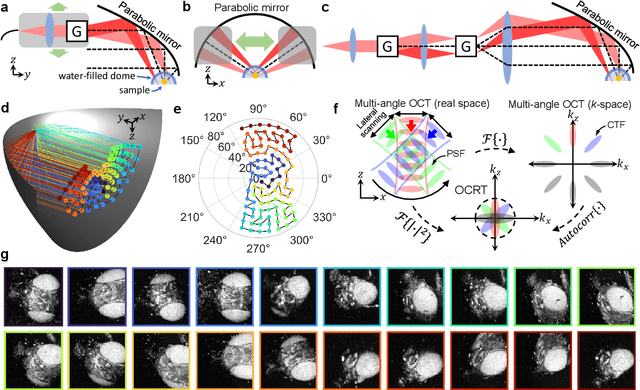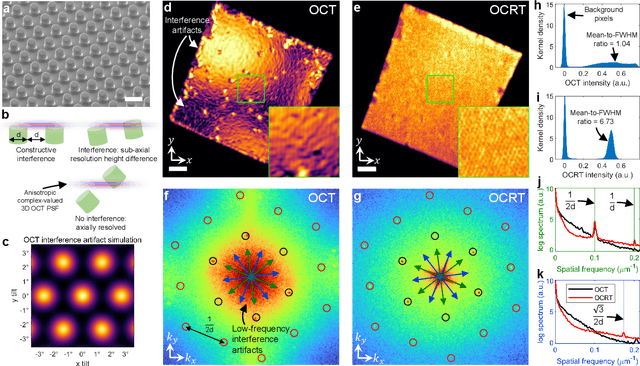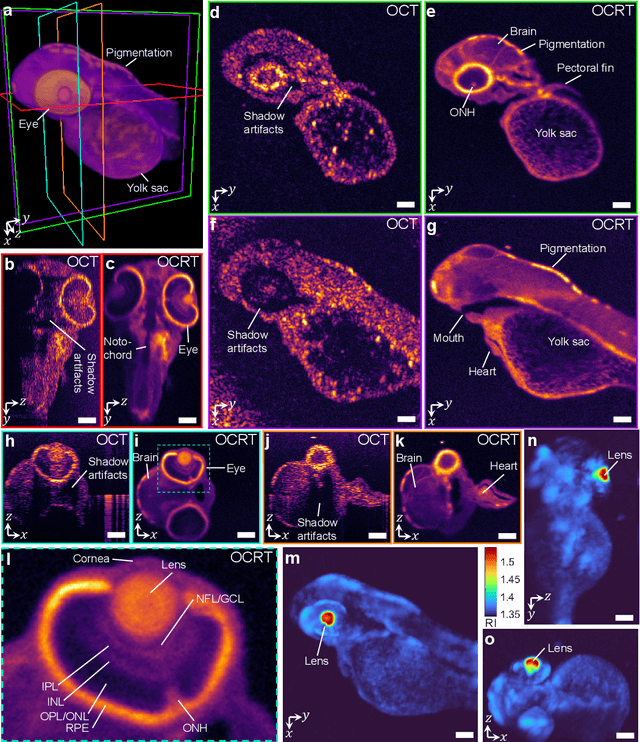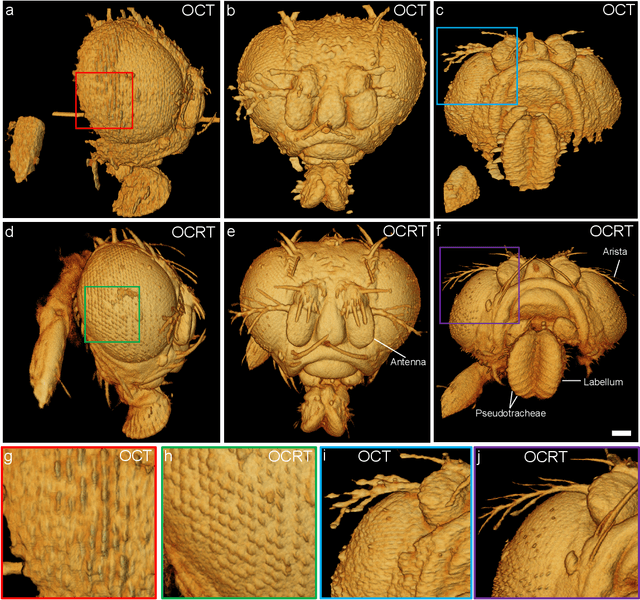Sina Farsiu
Reversible Unfolding Network for Concealed Visual Perception with Generative Refinement
Aug 20, 2025Abstract:Existing methods for concealed visual perception (CVP) often leverage reversible strategies to decrease uncertainty, yet these are typically confined to the mask domain, leaving the potential of the RGB domain underexplored. To address this, we propose a reversible unfolding network with generative refinement, termed RUN++. Specifically, RUN++ first formulates the CVP task as a mathematical optimization problem and unfolds the iterative solution into a multi-stage deep network. This approach provides a principled way to apply reversible modeling across both mask and RGB domains while leveraging a diffusion model to resolve the resulting uncertainty. Each stage of the network integrates three purpose-driven modules: a Concealed Object Region Extraction (CORE) module applies reversible modeling to the mask domain to identify core object regions; a Context-Aware Region Enhancement (CARE) module extends this principle to the RGB domain to foster better foreground-background separation; and a Finetuning Iteration via Noise-based Enhancement (FINE) module provides a final refinement. The FINE module introduces a targeted Bernoulli diffusion model that refines only the uncertain regions of the segmentation mask, harnessing the generative power of diffusion for fine-detail restoration without the prohibitive computational cost of a full-image process. This unique synergy, where the unfolding network provides a strong uncertainty prior for the diffusion model, allows RUN++ to efficiently direct its focus toward ambiguous areas, significantly mitigating false positives and negatives. Furthermore, we introduce a new paradigm for building robust CVP systems that remain effective under real-world degradations and extend this concept into a broader bi-level optimization framework.
Segment Concealed Objects with Incomplete Supervision
Jun 10, 2025Abstract:Incompletely-Supervised Concealed Object Segmentation (ISCOS) involves segmenting objects that seamlessly blend into their surrounding environments, utilizing incompletely annotated data, such as weak and semi-annotations, for model training. This task remains highly challenging due to (1) the limited supervision provided by the incompletely annotated training data, and (2) the difficulty of distinguishing concealed objects from the background, which arises from the intrinsic similarities in concealed scenarios. In this paper, we introduce the first unified method for ISCOS to address these challenges. To tackle the issue of incomplete supervision, we propose a unified mean-teacher framework, SEE, that leverages the vision foundation model, ``\emph{Segment Anything Model (SAM)}'', to generate pseudo-labels using coarse masks produced by the teacher model as prompts. To mitigate the effect of low-quality segmentation masks, we introduce a series of strategies for pseudo-label generation, storage, and supervision. These strategies aim to produce informative pseudo-labels, store the best pseudo-labels generated, and select the most reliable components to guide the student model, thereby ensuring robust network training. Additionally, to tackle the issue of intrinsic similarity, we design a hybrid-granularity feature grouping module that groups features at different granularities and aggregates these results. By clustering similar features, this module promotes segmentation coherence, facilitating more complete segmentation for both single-object and multiple-object images. We validate the effectiveness of our approach across multiple ISCOS tasks, and experimental results demonstrate that our method achieves state-of-the-art performance. Furthermore, SEE can serve as a plug-and-play solution, enhancing the performance of existing models.
* IEEE TPAMI
UnfoldIR: Rethinking Deep Unfolding Network in Illumination Degradation Image Restoration
May 10, 2025Abstract:Deep unfolding networks (DUNs) are widely employed in illumination degradation image restoration (IDIR) to merge the interpretability of model-based approaches with the generalization of learning-based methods. However, the performance of DUN-based methods remains considerably inferior to that of state-of-the-art IDIR solvers. Our investigation indicates that this limitation does not stem from structural shortcomings of DUNs but rather from the limited exploration of the unfolding structure, particularly for (1) constructing task-specific restoration models, (2) integrating advanced network architectures, and (3) designing DUN-specific loss functions. To address these issues, we propose a novel DUN-based method, UnfoldIR, for IDIR tasks. UnfoldIR first introduces a new IDIR model with dedicated regularization terms for smoothing illumination and enhancing texture. We unfold the iterative optimized solution of this model into a multistage network, with each stage comprising a reflectance-assisted illumination correction (RAIC) module and an illumination-guided reflectance enhancement (IGRE) module. RAIC employs a visual state space (VSS) to extract non-local features, enforcing illumination smoothness, while IGRE introduces a frequency-aware VSS to globally align similar textures, enabling mildly degraded regions to guide the enhancement of details in more severely degraded areas. This suppresses noise while enhancing details. Furthermore, given the multistage structure, we propose an inter-stage information consistent loss to maintain network stability in the final stages. This loss contributes to structural preservation and sustains the model's performance even in unsupervised settings. Experiments verify our effectiveness across 5 IDIR tasks and 3 downstream problems.
IQPFR: An Image Quality Prior for Blind Face Restoration and Beyond
Mar 12, 2025Abstract:Blind Face Restoration (BFR) addresses the challenge of reconstructing degraded low-quality (LQ) facial images into high-quality (HQ) outputs. Conventional approaches predominantly rely on learning feature representations from ground-truth (GT) data; however, inherent imperfections in GT datasets constrain restoration performance to the mean quality level of the training data, rather than attaining maximally attainable visual quality. To overcome this limitation, we propose a novel framework that incorporates an Image Quality Prior (IQP) derived from No-Reference Image Quality Assessment (NR-IQA) models to guide the restoration process toward optimal HQ reconstructions. Our methodology synergizes this IQP with a learned codebook prior through two critical innovations: (1) During codebook learning, we devise a dual-branch codebook architecture that disentangles feature extraction into universal structural components and HQ-specific attributes, ensuring comprehensive representation of both common and high-quality facial characteristics. (2) In the codebook lookup stage, we implement a quality-conditioned Transformer-based framework. NR-IQA-derived quality scores act as dynamic conditioning signals to steer restoration toward the highest feasible quality standard. This score-conditioned paradigm enables plug-and-play enhancement of existing BFR architectures without modifying the original structure. We also formulate a discrete representation-based quality optimization strategy that circumvents over-optimization artifacts prevalent in continuous latent space approaches. Extensive experiments demonstrate that our method outperforms state-of-the-art techniques across multiple benchmarks. Besides, our quality-conditioned framework demonstrates consistent performance improvements when integrated with prior BFR models. The code will be released.
RUN: Reversible Unfolding Network for Concealed Object Segmentation
Jan 30, 2025



Abstract:Existing concealed object segmentation (COS) methods frequently utilize reversible strategies to address uncertain regions. However, these approaches are typically restricted to the mask domain, leaving the potential of the RGB domain underexplored. To address this, we propose the Reversible Unfolding Network (RUN), which applies reversible strategies across both mask and RGB domains through a theoretically grounded framework, enabling accurate segmentation. RUN first formulates a novel COS model by incorporating an extra residual sparsity constraint to minimize segmentation uncertainties. The iterative optimization steps of the proposed model are then unfolded into a multistage network, with each step corresponding to a stage. Each stage of RUN consists of two reversible modules: the Segmentation-Oriented Foreground Separation (SOFS) module and the Reconstruction-Oriented Background Extraction (ROBE) module. SOFS applies the reversible strategy at the mask level and introduces Reversible State Space to capture non-local information. ROBE extends this to the RGB domain, employing a reconstruction network to address conflicting foreground and background regions identified as distortion-prone areas, which arise from their separate estimation by independent modules. As the stages progress, RUN gradually facilitates reversible modeling of foreground and background in both the mask and RGB domains, directing the network's attention to uncertain regions and mitigating false-positive and false-negative results. Extensive experiments demonstrate the superior performance of RUN and highlight the potential of unfolding-based frameworks for COS and other high-level vision tasks. We will release the code and models.
Spatial Coherence Loss for Salient and Camouflaged Object Detection and Beyond
Feb 28, 2024Abstract:Generic object detection is a category-independent task that relies on accurate modeling of objectness. Most relevant CNN-based models of objectness utilize loss functions (e.g., binary cross entropy) that focus on the single-response, i.e., the loss response of a single pixel. Inspired by the human visual system, which first discerns the boundaries of ambiguous regions (i.e., hard regions) before delving into the semantic meaning, we propose a novel loss function, Spatial Coherence Loss (SCLoss), that uses the mutual response between adjacent pixels to suppress or emphasize the single-response of pixels. We demonstrate that the proposed SCLoss can gradually learn the hard regions by detecting and emphasizing their boundaries. Through comprehensive experiments, we demonstrate that replacing popular loss functions with SCLoss can improve the performance of current state-of-the-art (SOTA) salient or camouflaged object detection (SOD or COD) models. We also demonstrate that combining SCLoss with other loss functions can further improve performance and result in the SOTA outcomes for different applications. Finally, as a demonstrative example of the potential uses for other related tasks, we show an application of SCLoss for semantic segmentation.
Directional Connectivity-based Segmentation of Medical Images
Mar 31, 2023Abstract:Anatomical consistency in biomarker segmentation is crucial for many medical image analysis tasks. A promising paradigm for achieving anatomically consistent segmentation via deep networks is incorporating pixel connectivity, a basic concept in digital topology, to model inter-pixel relationships. However, previous works on connectivity modeling have ignored the rich channel-wise directional information in the latent space. In this work, we demonstrate that effective disentanglement of directional sub-space from the shared latent space can significantly enhance the feature representation in the connectivity-based network. To this end, we propose a directional connectivity modeling scheme for segmentation that decouples, tracks, and utilizes the directional information across the network. Experiments on various public medical image segmentation benchmarks show the effectiveness of our model as compared to the state-of-the-art methods. Code is available at https://github.com/Zyun-Y/DconnNet.
RetiFluidNet: A Self-Adaptive and Multi-Attention Deep Convolutional Network for Retinal OCT Fluid Segmentation
Sep 26, 2022



Abstract:Optical coherence tomography (OCT) helps ophthalmologists assess macular edema, accumulation of fluids, and lesions at microscopic resolution. Quantification of retinal fluids is necessary for OCT-guided treatment management, which relies on a precise image segmentation step. As manual analysis of retinal fluids is a time-consuming, subjective, and error-prone task, there is increasing demand for fast and robust automatic solutions. In this study, a new convolutional neural architecture named RetiFluidNet is proposed for multi-class retinal fluid segmentation. The model benefits from hierarchical representation learning of textural, contextual, and edge features using a new self-adaptive dual-attention (SDA) module, multiple self-adaptive attention-based skip connections (SASC), and a novel multi-scale deep self supervision learning (DSL) scheme. The attention mechanism in the proposed SDA module enables the model to automatically extract deformation-aware representations at different levels, and the introduced SASC paths further consider spatial-channel interdependencies for concatenation of counterpart encoder and decoder units, which improve representational capability. RetiFluidNet is also optimized using a joint loss function comprising a weighted version of dice overlap and edge-preserved connectivity-based losses, where several hierarchical stages of multi-scale local losses are integrated into the optimization process. The model is validated based on three publicly available datasets: RETOUCH, OPTIMA, and DUKE, with comparisons against several baselines. Experimental results on the datasets prove the effectiveness of the proposed model in retinal OCT fluid segmentation and reveal that the suggested method is more effective than existing state-of-the-art fluid segmentation algorithms in adapting to retinal OCT scans recorded by various image scanning instruments.
Computational 3D microscopy with optical coherence refraction tomography
Feb 24, 2022



Abstract:Optical coherence tomography (OCT) has seen widespread success as an in vivo clinical diagnostic 3D imaging modality, impacting areas including ophthalmology, cardiology, and gastroenterology. Despite its many advantages, such as high sensitivity, speed, and depth penetration, OCT suffers from several shortcomings that ultimately limit its utility as a 3D microscopy tool, such as its pervasive coherent speckle noise and poor lateral resolution required to maintain millimeter-scale imaging depths. Here, we present 3D optical coherence refraction tomography (OCRT), a computational extension of OCT which synthesizes an incoherent contrast mechanism by combining multiple OCT volumes, acquired across two rotation axes, to form a resolution-enhanced, speckle-reduced, refraction-corrected 3D reconstruction. Our label-free computational 3D microscope features a novel optical design incorporating a parabolic mirror to enable the capture of 5D plenoptic datasets, consisting of millimetric 3D fields of view over up to $\pm75^\circ$ without moving the sample. We demonstrate that 3D OCRT reveals 3D features unobserved by conventional OCT in fruit fly, zebrafish, and mouse samples.
BiconNet: An Edge-preserved Connectivity-based Approach for Salient Object Detection
Feb 27, 2021



Abstract:Salient object detection (SOD) is viewed as a pixel-wise saliency modeling task by traditional deep learning-based methods. Although great progress has been made, a challenge of modern SOD models is the insufficient utilization of inter-pixel information, which usually results in imperfect segmentations near the edge regions. As we demonstrate, using a saliency map as the network output is a sub-optimal choice. To address this problem, we propose a connectivity-based approach named bilateral connectivity network (BiconNet), which uses a connectivity map instead of a saliency map as the network output for effective modeling of inter-pixel relationships and object saliency. Moreover, we propose a bilateral voting module to enhance the output connectivity map and a novel edge feature enhancement method that efficiently utilizes edge-specific features with negligible parameter increase. We show that our model can use any existing saliency-based SOD framework as its backbone. Through comprehensive experiments on five benchmark datasets, we demonstrate that our proposed method outperforms state-of-the-art SOD approaches.
 Add to Chrome
Add to Chrome Add to Firefox
Add to Firefox Add to Edge
Add to Edge